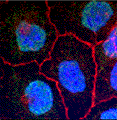Biochemistry, Department of
Document Type
Article
Date of this Version
9-14-2007
Abstract
The Ctr1 family of integral membrane proteins is necessary for high affinity copper uptake in eukaryotes. Ctr1 is also involved in cellular accumulation of cisplatin, a platinum-based anticancer drug. Although the physiological role of Ctr1 has been revealed, the mechanism of action of Ctr1 remains to be elucidated. To gain a better understanding of Ctr1-mediated copper and cisplatin transport, we have monitored molecular dynamics and transport activities of yeast Saccharomyces cerevisiae Ctr1 and its mutant alleles. Co-expression of functional Ctr1 monomers fused with either cyan or yellow fluorescent protein resulted in fluorescence resonance energy transfer (FRET), which is consistent with multimer assembly of Ctr1. Copper near the Km value of Ctr1 enhanced FRET in a manner that correlated with cellular copper transport. In vitro cross-linking of Ctr1 confirmed that copper-induced FRET reflects conformational changes within pre-existing Ctr1 complexes. FRET assays in membrane-disrupted cells and protein extracts showed that intact cell structure is necessary for Ctr1 activity. Despite Ctr1-dependent cellular accumulation, cisplatin did not change Ctr1 FRET nor did it attenuate copper-induced FRET. A Ctr1 allele defective in copper transport enhanced cellular cisplatin accumulation. N-terminal methionine-rich motifs that are dispensable for copper transport play a critical role for cisplatin uptake. Taken together, our data reveal functional roles for structural remodeling of the Ctr1 multimeric complex in copper transport and suggest distinct mechanisms employed by Ctr1 for copper and cisplatin transport.



Comments
Published in The Journal of Biological Chemistry 282:37 (September 14, 2007), pp. 26775-26785; doi 10.1074/jbc.M703973200 Copyright © 2007 by The American Society for Biochemistry and Molecular Biology, Inc. Used by permission. http://www.jbc.org
The research reported in this paper was supported by National Institutes of Health (NIH) Grant P20-RR-17675 (project 3 to J. L.), NIH Grant DK79209 (to Jaekwon Lee), a Nutricia Foundation pre-doctoral fellowship (to Devis Sinani), and funds provided through the Hatch Act in the University of Nebraska Agricultural Research Division.